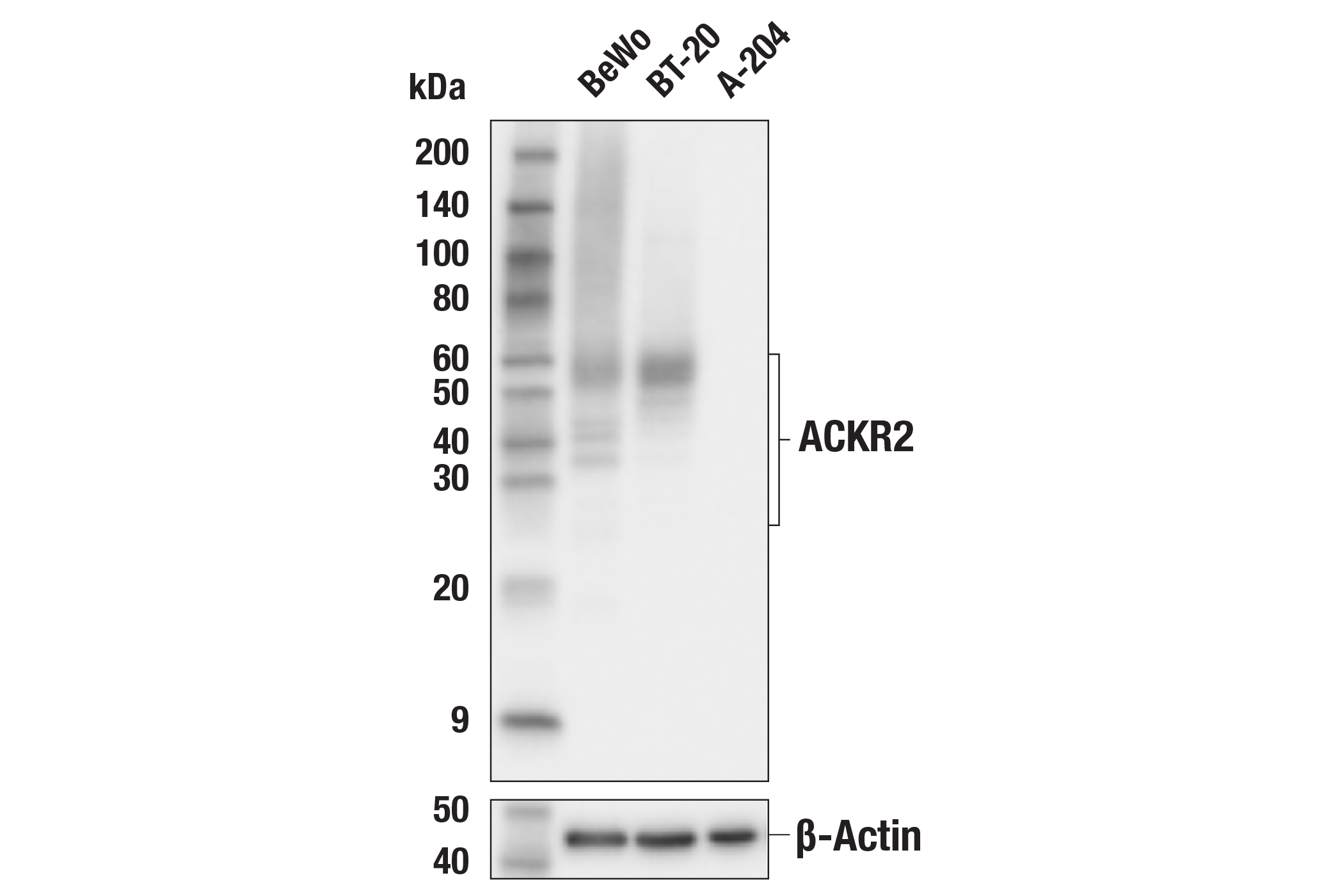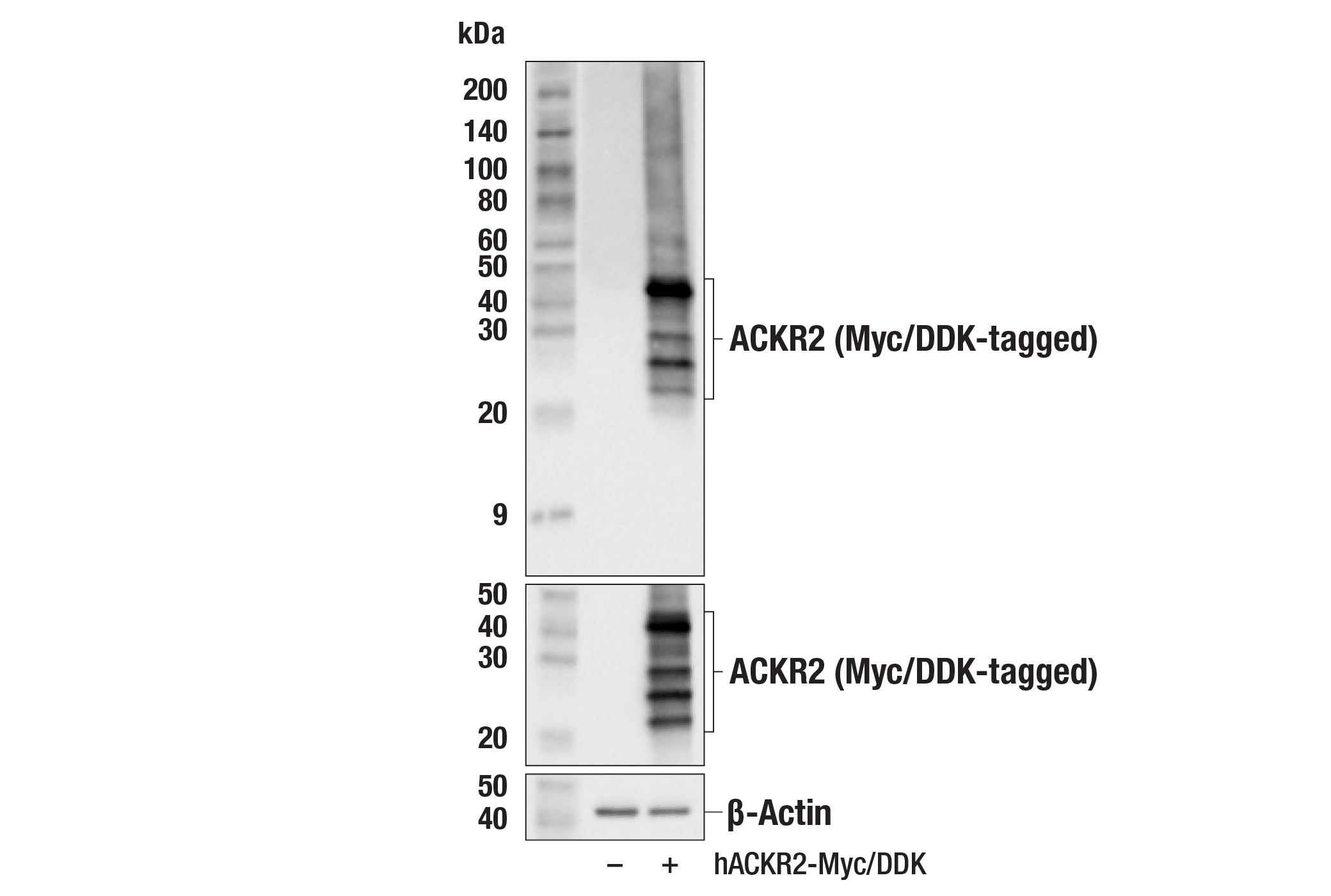WB
H
Endogenous
35-55
Rabbit IgG
#O00590
1238
Product Information
Product Usage Information
| Application | Dilution |
|---|---|
| Western Blotting | 1:1000 |
Storage
Specificity / Sensitivity
Species Reactivity:
Human
Source / Purification
Monoclonal antibody is produced by immunizing animals with a synthetic peptide corresponding to residues near the carboxy terminus of human ACKR2 protein.
Background
Chemokines are small, secreted proteins that regulate immune and inflammatory responses, controlling leukocyte migration and localization (1,4,6). Chemokine signaling is typically regulated through G protein-coupled chemokine receptors (CCRs). However, chemokines can also bind to a small family of atypical chemokine receptors (ACKRs) (2,6). ACKR2 has been shown to act as a scavenger for most inflammatory chemokines and to negatively regulate inflammation (4,5). By scavenging chemokines in tissues and on surfaces of lymphatic vessels, ACKR2 plays a vital role in the dissolution of inflammatory responses, regulating adaptive immune response, and autoimmunity (3,5,7). ACKR2 can act as a mediator of signaling between inflammatory leukocytes and lymphatic endothelial cells and has been implicated in dendritic cell maturation (4,5). ACKR2 is expressed in hematopoietic precursors and downregulated during myeloid differentiation (5). Loss of ACKR2 in mouse models has been shown to increase inflammation and tumor growth (2,4). ACKRs are emerging as crucial regulatory components of chemokine networks in a wide range of developmental, physiological, and pathological contexts.
- Nibbs, R.J. and Graham, G.J. (2013) Nat Rev Immunol 13, 815-29.
- Hansell, C.A.H. et al. (2018) J Immunol 201, 2510-2519.
- Hansell, C.A. et al. (2015) Immunol Cell Biol 93, 167-76.
- Massara, M. et al. (2018) Nat Commun 9, 676.
- Murcia, J.D.G. et al. (2020) Sci Rep 10, 8019.
- Hewit, K.D. et al. (2014) J Biol Chem 289, 12330-42.
- Baldwin, H.M. et al. (2017) Rheumatology (Oxford) 56, 1607-1617.
Species Reactivity
Species reactivity is determined by testing in at least one approved application (e.g., western blot).
Western Blot Buffer
IMPORTANT: For western blots, incubate membrane with diluted primary antibody in 5% w/v BSA, 1X TBS, 0.1% Tween® 20 at 4°C with gentle shaking, overnight.
Applications Key
WB: Western Blotting
Cross-Reactivity Key
H: human M: mouse R: rat Hm: hamster Mk: monkey Vir: virus Mi: mink C: chicken Dm: D. melanogaster X: Xenopus Z: zebrafish B: bovine Dg: dog Pg: pig Sc: S. cerevisiae Ce: C. elegans Hr: horse GP: Guinea Pig Rab: rabbit All: all species expected
Trademarks and Patents
Limited Uses
Except as otherwise expressly agreed in a writing signed by a legally authorized representative of CST, the following terms apply to Products provided by CST, its affiliates or its distributors. Any Customer's terms and conditions that are in addition to, or different from, those contained herein, unless separately accepted in writing by a legally authorized representative of CST, are rejected and are of no force or effect.
Products are labeled with For Research Use Only or a similar labeling statement and have not been approved, cleared, or licensed by the FDA or other regulatory foreign or domestic entity, for any purpose. Customer shall not use any Product for any diagnostic or therapeutic purpose, or otherwise in any manner that conflicts with its labeling statement. Products sold or licensed by CST are provided for Customer as the end-user and solely for research and development uses. Any use of Product for diagnostic, prophylactic or therapeutic purposes, or any purchase of Product for resale (alone or as a component) or other commercial purpose, requires a separate license from CST. Customer shall (a) not sell, license, loan, donate or otherwise transfer or make available any Product to any third party, whether alone or in combination with other materials, or use the Products to manufacture any commercial products, (b) not copy, modify, reverse engineer, decompile, disassemble or otherwise attempt to discover the underlying structure or technology of the Products, or use the Products for the purpose of developing any products or services that would compete with CST products or services, (c) not alter or remove from the Products any trademarks, trade names, logos, patent or copyright notices or markings, (d) use the Products solely in accordance with CST Product Terms of Sale and any applicable documentation, and (e) comply with any license, terms of service or similar agreement with respect to any third party products or services used by Customer in connection with the Products.

